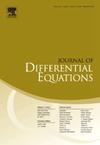Zero dissipation and time decay rates to the planar rarefaction wave for 3-D compressible Euler equation in the whole space
IF 2.4
2区 数学
Q1 MATHEMATICS
引用次数: 0
Abstract
We investigate the large-time behavior and inviscid limit of solutions to a class of three-dimensional (3D) viscous hyperbolic systems, focusing on their convergence toward a planar rarefaction wave of the 3D isentropic compressible Euler equation. We prove that the planar rarefaction wave is time-asymptotically stable and the solutions converge to the Euler planar rarefaction wave. Notably, decay rates that depends explicitly on both time and the viscosity coefficient are obtained. Moreover, the strength of the rarefaction wave can be large, and the initial perturbation is in the whole space. To the best of our knowledge, this is the first result to derive both the time-dependent and viscosity-dependent dissipation rates for rarefaction waves. Further, it is also the first result which successfully obtained the time decay rate around the planar rarefaction wave in the case of systems.
To address the error terms arising from approximating the viscous hyperbolic system with the inviscid planar rarefaction wave, we construct a new smooth viscous profile using Riemann invariants. This profile satisfies a one-dimensional (1D) parabolic system and serves as an effective approximation to the planar rarefaction wave. By applying a scaling transformation and deriving delicate time-weighted -energy estimates, we establish a uniform convergence rate to the planar rarefaction wave. Moreover, the result is in the whole space, which means we don't need any periodic assumptions on any spatial directions.
求助全文
约1分钟内获得全文
求助全文
来源期刊
CiteScore
4.40
自引率
8.30%
发文量
543
审稿时长
9 months
期刊介绍:
The Journal of Differential Equations is concerned with the theory and the application of differential equations. The articles published are addressed not only to mathematicians but also to those engineers, physicists, and other scientists for whom differential equations are valuable research tools.
Research Areas Include:
• Mathematical control theory
• Ordinary differential equations
• Partial differential equations
• Stochastic differential equations
• Topological dynamics
• Related topics

 求助内容:
求助内容: 应助结果提醒方式:
应助结果提醒方式:


